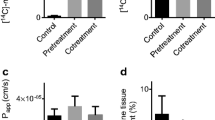Abstract
The effect of the penetration enhancers Azone, oleic acid, 1-dodecanol, dodecyl N,N-dimethylaminoacetate (DDAA), and dodecyl N,N-dimethylaminoisopropionate (DDAIP) on epithelial membrane lipids was examined using human buccal cell membranes as a model for epithelial lipid bilayer. Buccal epithelial cells (BEC) were labeled with l,6-diphenyl-l,3,5-hexatriene (DPH), l-(4-(trimethylammonio)phenyl)-6-phenyl-l,3,5-hexatriene (TMA-DPH), and 8-anilino-l-naphthalene sulphonic acid (ANS) fluorophores to characterize enhancer-induced changes in the hydrophobic core, in the superficial polar head region, and on the exterior surface, respectively, with fluorescence anisotropy and fluorescence lifetimes. All the enhancers studied were found to decrease the BEC membrane lipid packing order in a concentration-dependent and time-dependent manner in the deep bilayer region, as shown by a 37–66% decrease in anisotropy. Oleic acid was also found to disrupt membrane lipids strongly in the polar head region, causing at least a 34% decrease in anisotropy values. Azone and DDAA were shown to alter molecular movement on the surface of the bilayers (24 and 19% decrease in anisotropy, respectively). The results suggest that interaction with membrane lipid domains is an important, but not the only, mode of action for the penetration enhancers studied.
Similar content being viewed by others
REFERENCES
P. M. Elias and D. S. Friend. The permeability barrier in mammalian epidermis. J. Cell Biol. 65:180–191 (1975).
P. M. Elias, J. Goerke, and D. S. Friend. Mammalian epidermal barrier layer lipids: Composition and influence on structure. J. Invest. Dermatol. 69:535–546 (1977).
C. A. Squier and R. M. Hopps. A study of the permeability barrier in epidermis and oral epithelium using horseradish peroxidase as a tracer in vitro. Br. J. Dermatol. 95:123–129 (1976).
G. M. Golden, D. B. Guzek, A. H. Kennedy, J. E. McKie, and R. O. Potts. Stratum corneum lipid phase transitions and water barrier properties. Biochemistry 26:2382–2388 (1987).
V. H. W. Mak, R. O. Potts, and R. H. Guy. Oleic acid concentration and effect in human stratum corneum: Noninvasive determination by attenuated total reflectance infrared spectroscopy in vivo. J. Control Rel. 12:67–75 (1990).
M. L. Francoeur, G. M. Golden, and R. O. Potts. Oleic acid: Its effects on stratum corneum in relation to (trans)dermal drug delivery. Pharm. Res. 7:621–627 (1990).
W. J. Van Blitterswijk, R. P. van Hoeven, and B. W. Van der Meer. Lipid structural order parameters (reciprocal of fluidity) in biomembranes derived from steady-state fluorescence polarization measurements. Biochim. Biophys. Acta 644:323–332 (1981).
H. Pottel, B. W. Van der Meer, and W. Herreman. Correlation between the order parameter and the steady-state fluorescence anisotropy of 1,6-diphenyl-1,3,5-hexatriene and an evaluation of membrane fluidity. Biochim. Biophys. Acta 730:181–186 (1983).
F. G. Prendergast, R. P. Haugland, and P. J. Callahan. 1-[4-(Trimethylamino)phenyl]-6-phenylhexa-1,3,5-triene: Synthesis, fluorescence properties and use as a fluorescence probe of lipid bilayers. Biochemistry 20:7333–7338 (1981).
C. A. Squier, P. Cox, and P. W. Wertz. Lipid content and water permeability of skin and oral mucosa. J. Invest. Dermatol. 96:123–126 (1991).
O. Wong, J. Huntington, T. Nishihata, and J. H. Rytting. New alkyl N,N-dialkyl-substituted amino acetates as transdermal penetration enhancers. Pharm. Res. 6:286–295 (1989).
S. Buyuktimkin, N. Buyuktimkin, and J. H. Rytting. Synthesis and enhancing effect of 2-dodecyl transepidermal (N,N-dimethylamino) propionate (DDAIP) on the delivery of indomethacin, clonidine and hydrocortisone. Pharm. Res. 10:1632–1637 (1993).
K. L. Audus and M. A. Gordon. Effect of tricylic antidepressant drugs on lymphocyte membrane structure. J. Immunopharmacol. 6:105–132 (1984).
G. M. Omann, Z. G. Oades, and L. A. Sklar. Simultaneous spectrofluorometric analyses of cell responses. BioTechniques 3:508–512 (1985).
J. R. Lakowicz. Principles of Fluorescence Spectroscopy, Plenum Press, New York, 1983.
L. A. Sklar. Fluorescence polarization studies of membrane fluidity: Where do we go from here? In M. Kates and L. A. Manson (eds.), Biomembranes, Vol. 12, Plenum Press, New York, 1984, pp. 99–131.
M. Donner, S. Muller, and J. F. Stoltz. Fluorescence depolarization method in the study of dynamic properties of blood cells. Biorheology 27:367–374 (1990).
M. T. Flanagan and T. R. Hesketh. Electrostatic interactions in the binding of fluorescent probes to lipid membranes. Biochim. Biophys. Acta 298:535–545 (1973).
R. O. Potts, N. Azimi, T. S. Spencer, D. A. Chen, and F. E. Lytle. Fluorescence spectroscopic evaluation of stratum corneum lipids. Proc. Int. Symp. Control Rel. Bioact. Mater. 19:141–142 (1992).
E. LeCluyse, L. Appel, and S. C. Sutton. Relationship between drug absorption enhancing activity and membrane perturbing effects of acylcarnitines. Pharm. Res. 8:84–87 (1991).
D. Bommannan, R. O. Potts, and R. H. Guy. Examination of the effect of ethanol on human stratum corneum in vivo using infrared spectroscopy. J. Control. Rel. 16:299–304 (1991).
T. Kurihara-Bergstrom, K. Knutson, L. DeNoble, and C. Y. Goates. Percutaneous absorption enhancement of an ionic molecule by ethanol-water systems in human skin. Pharm. Res. 7:762–766 (1990).
V. H. W. Mak, R. O. Potts, and R. H. Guy. Percutaneous penetration enhancement in vivo measured by attenuated total reflectance infrared spectroscopy. Pharm. Res. 7:835–841 (1990).
K. Sugibayashi, S. Nakayama, T. Seki, K.-I. Hosoya, and Y. Morimoto. Mechanism of skin penetration-enhancing effect by laurocapram. J. Pharm. Sci. 81:58–64 (1992).
W. J. Lambert, W. I. Higuchi, K. Knutson, and S. L. Krill. Dose-dependent enhancement effects of Azone on skin permeability. Pharm. Res. 6:798–803 (1989).
J. Hirvonen, J. H. Rytting, P. Paronen, and A. Urtti. Dodecyl N,N-dimethylamino acetate and Azone enhance drug penetration across human, snake and rabbit skin. Pharm. Res. 8:933–937 (1991).
T. M. Turunen, S. Buyuktimkin, N. Buyuktimkin, A. Urtti, P. Paronen, and J. H. Rytting. Enhanced delivery of 5-fluorouracil through shed snake skin by two new transdermal penetration enhancers. Int. J. Pharm. 92:89–95 (1993).
Author information
Authors and Affiliations
Rights and permissions
About this article
Cite this article
Turunen, T.M., Urtti, A., Paronen, P. et al. Effect of Some Penetration Enhancers on Epithelial Membrane Lipid Domains: Evidence from Fluorescence Spectroscopy Studies. Pharm Res 11, 288–294 (1994). https://doi.org/10.1023/A:1018919811227
Issue Date:
DOI: https://doi.org/10.1023/A:1018919811227




